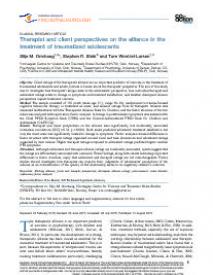Therapist and client perspectives on the alliance in the treatment of traumatized adolescents
Objective: Client ratings of the therapeutic alliance are an important predictor of outcome in the treatment of traumatized adolescents and adults, but less is known about the therapists’ perspective. The aim of this study was to investigate how therapists’ ratings relate to the adolescents’ perspective, how individual therapist and adolescent ratings relate to change in symptoms and treatment satisfaction, and whether discrepant alliance perspectives impact treatment outcome.
Method: The sample consisted of 156 youth (mean age 15.1, range 10–18), randomized to trauma-focused cognitive behavioral therapy or treatment as usual, and alliance ratings from 62 therapists. Alliance was measured midtreatment with the Therapeutic Alliance Scale for Children, and the factor structure of the two scales was analyzed with exploratory factor analyses. A change in posttraumatic symptoms was assessed with the Child PTSD Symptom Scale (CPSS) and the Clinicial-Administered PTSD Scale for Children and Adolescents (CAPS-CA).
Results: Therapist and client perspectives on the alliance were significantly, but moderately, associated (intraclass correlations [ICC]=0.54, p<0.001). Both scales predicted adolescent treatment satisfaction but only the client scale was significantly related to change in symptoms. Factor analyses revealed differences in factor structure with therapist ratings organized around bond and task dimensions and adolescent ratings organized by item valence. Higher therapist ratings compared to adolescent ratings predicted higher residual PTS symptoms.
Discussion: Although adolescent and therapist alliance ratings are moderately associated, results suggest that the ratings are differentially associated with outcomes. These findings, along with results indicating important differences in factor structure, imply that adolescent and therapist ratings are not interchangeable. Future studies should investigate how therapists can improve their judgments of adolescents’ perceptions of the alliance as an overestimation of the quality of the relationship seems to be negatively related to outcome.
Geachte bezoeker,
De informatie die u nu opvraagt, kan door psychotraumanet niet aan u worden getoond. Dit kan verschillende redenen hebben,
waarvan (bescherming van het) auteursrecht de meeste voorkomende is. Wanneer het mogelijk is om u door te verwijzen naar de bron
van deze informatie, dan ziet u hier onder een link naar die plek.
Als er geen link staat, kunt u contact opnemen met de bibliotheek,
die u verder op weg kan helpen.
Met vriendelijke groet,
Het psychotraumanet-team.
Reference:
Silje M. Ormhaug, Stephen R. Shirk, & Tore Wentzel-Larsen | 2015
European journal of psychotraumatology, ISSN 2000-8066 | 6 | 27705
http://www.ejpt.net/index.php/ejpt/article/view/27705
European journal of psychotraumatology, ISSN 2000-8066 | 6 | 27705
http://www.ejpt.net/index.php/ejpt/article/view/27705


